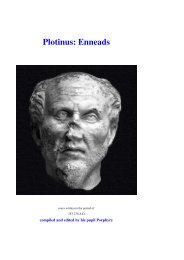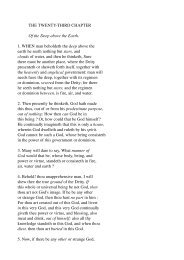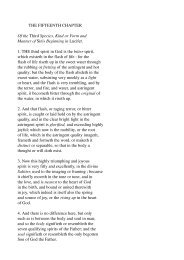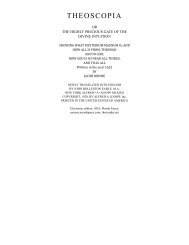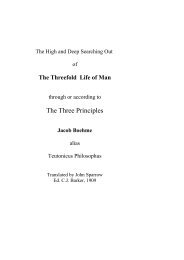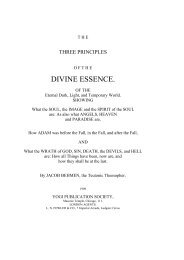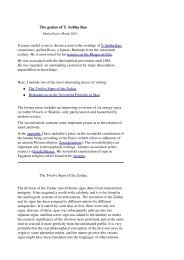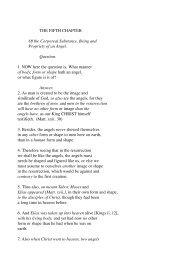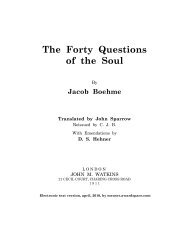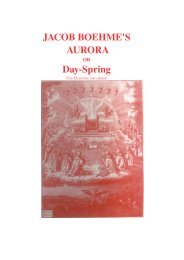Gerald Massey's Lectures - Society in evolution - Awardspace
Gerald Massey's Lectures - Society in evolution - Awardspace
Gerald Massey's Lectures - Society in evolution - Awardspace
Create successful ePaper yourself
Turn your PDF publications into a flip-book with our unique Google optimized e-Paper software.
Bis-Bis, identified by George Smith with the crocodile as the symbol of Egypt; and<br />
Ishtar=Venus, the "Lady of Dawn," was called Bis-bisi, which shows the survival of the<br />
same genetrix <strong>in</strong> her change of character out of space <strong>in</strong>to time. Another proof of this<br />
cont<strong>in</strong>uity by transformation is furnished when Ishtar as Queen of Heaven (so rendered<br />
by Mr. Sayce) called herself the "Unique Monster" (p. 267.) Precisely <strong>in</strong> the same way do<br />
we see the Typhonian genetrix Ta-Urt <strong>in</strong> Egypt pass <strong>in</strong>to Hes-ta-Urt (whence Hestaroth<br />
or Ashtaroth) and Hathor, when the domesticated cow succeeded the water-cow as the<br />
Zoötype of Hes, As (Isis), or of Hathor, the Lunar form of the Goddess of Love, <strong>in</strong> whose<br />
person the beast was transfigured <strong>in</strong>to the beauty.<br />
Accord<strong>in</strong>g to ancient tradition, the culture of Chaldea was brought to that country by a<br />
Fish-Man, who rose up <strong>in</strong> "the first year," from that part of the Red or "Erythræan Sea<br />
which borders upon Babylonia." The orig<strong>in</strong>al of this type can be identified <strong>in</strong> Ea the fishgod,<br />
deity of the house of the deep and div<strong>in</strong>ity of wisdom. Whence came Ea, then, by<br />
the Red Sea? Lepsius says from Egypt--so says Egypt herself.<br />
Professor Sayce had previously denied our right to compare the myths of two different<br />
nations before their relationships have been established by language, and that by<br />
grammar (which is late), <strong>in</strong> preference to the vocabulary. Thus mythology is put out of<br />
court, and words are to be accounted of no weight. Still, it is well to remember that the<br />
Professor has before now taken his stand on a false bottom that was found to be<br />
crumbl<strong>in</strong>g under foot day by day! It is at least suggestive to f<strong>in</strong>d that the name and nature<br />
of Ea, the oldest Akkadian form of the One God, may be so fully expla<strong>in</strong>ed by the<br />
Egyptian Uâ (later Ea) for the one, the one alone, isolated as the only one; also the<br />
Th<strong>in</strong>ker and the Capta<strong>in</strong> of the Boat. It should be premised that the Egyptian U preceded<br />
the letter or sound of E, hence Ua=Ea. The Egyptian Ua, which passed <strong>in</strong>to Ea, also<br />
appears <strong>in</strong> the Akkadian Ua for the Supreme One, the sole Lord or Chief. In one form Ea<br />
is the fish-god, and the hieroglyphic sign for Ua=Ea is fish<strong>in</strong>g-tackle! Ea was the deity of<br />
the deep, and Ua=Ea is Boat and Capta<strong>in</strong> both. Of course the fish was the earlier image,<br />
but the Egyptians had gone far ahead <strong>in</strong> substitut<strong>in</strong>g the work of their own hands for the<br />
primitive natural types. Ea is the wise god, the th<strong>in</strong>ker and <strong>in</strong>structor; and Uaua (Eg.)<br />
means to th<strong>in</strong>k, consider, meditate. Ea's prototype <strong>in</strong> the <strong>in</strong>def<strong>in</strong>itely earlier mythology of<br />
Egypt is Num=Kneph, whose twofold nature is <strong>in</strong>dicated by the two ways of spell<strong>in</strong>g one<br />
name. As Num he is Lord of the <strong>in</strong>undation; as Kneph he is the Breath of those who are<br />
<strong>in</strong> the firmament. Nef signifies breath, and is also the name of the sailor. Ea is god of the<br />
watercourse and the atmosphere. Ea was the Antelope of the deep; Num was the bearded<br />
He-goat; the Sea-goat of the Zodiac. One type of Num is the serpent; as it is of Ea. Ea is<br />
said to represent the House, which is â <strong>in</strong> Egyptian. In a case of this k<strong>in</strong>d Professor Sayce<br />
can only perceive or will only admit a "general analogy."<br />
Egyptian also offers the likeliest orig<strong>in</strong>al for the name of Oan or Oannes, the Greek form<br />
of Ea, the fish, see<strong>in</strong>g that Ua=Oa, and that An is the fish <strong>in</strong> Egyptian; whilst An, to<br />
appear, to show, is determ<strong>in</strong>ed by the fish <strong>in</strong> the water-prec<strong>in</strong>ct, where the fish is the<br />
revealer who emerged from the waters as Ea-an, or Oannes. (Denkmäler 3, 46 C.) If the<br />
orig<strong>in</strong>al Fish-Man came from Egypt, it would probably be as the Crocodile=Dragon, the<br />
Typhonian type of both the ancient mother and her son Sevekh. The crocodile is the fish<br />
that passes the day on dry land and the night <strong>in</strong> the waters. Its name of Sevekh is identical<br />
with that of the number seven; and Ea is connected with a typical fish of seven f<strong>in</strong>s (?).<br />
The crocodile, as Plutarch tells us, was a supreme type of the one God, or, as the name<br />
shows, of the seven-fold powers <strong>in</strong> one image. Sevekh was the same good demon of one<br />
Cult <strong>in</strong> Egypt that Num-Ra was <strong>in</strong> the other, but <strong>in</strong>def<strong>in</strong>itely earlier.<br />
To my apprehension, the Babylonian "House of the Seven bonds of heaven and earth," is<br />
identical with the "House of the Seven Halls and Seven stairways," assigned to Osiris;<br />
and the God Nebo as stellar, lunar, and planetary Deity; as prophet and proclaimer, is<br />
identical with Sut-Anup (later Nub and Anubis) <strong>in</strong> a dozen different aspects; whilst



